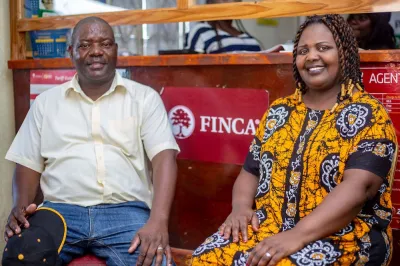A Second Wave of Economic Hardship May Be Looming for MFI Clients

The COVID-19 pandemic and subsequent lockdowns have had major repercussions globally. Microentrepreneurs, the lifeblood of many economies, have been left struggling to keep their businesses afloat and their families safe.
60 Decibels, a global social impact research firm, in partnership with the Social Performance Task Force (SPTF) and its members, has been speaking to microfinance clients around the world to understand how they are being impacted by COVID-19, and what microfinance institutions (MFIs) can do to best support them. The research has been conducted in partnership with 15 MFIs across 12 countries in Asia and Africa, with monthly data collected by phone beginning in July 2020. So far, we’ve heard from 4,892 clients.
Overall, microfinance clients have taken a major financial hit due to the COVID-19 pandemic. The vast majority of clients report a high level of concern and a significant worsening of their financial situation. Most are deeply worried about their ability to earn an income in the near future. To cope with a drop in incomes, most clients are using savings, reducing investments, borrowing money or selling assets as coping mechanisms. Looking at the survey results in greater detail, the following are our top three findings so far.
1. Repayment burdens are high and requests for new loans or payment deferments are common.
Despite the fact that MFIs have been offering payment deferrals – 63 percent of MFIs are doing so, according to recent CGAP data – clients are still facing high repayment burdens, and many are asking for additional capital. Keeping up with payments is difficult for clients: 49 percent of the clients we spoke to find payments to be a burden, and half of those clients say they are a “heavy burden.” Not surprisingly, 63 percent of clients say this burden has increased since the start of the pandemic.
Even more troubling, CGAP data shows that 69 percent of MFIs have reduced lending, and of these, 57 percent have reduced lending by more than half of pre-COVID levels. This reduction in lending goes directly against what borrowers told us they need most. In an open-ended question, we asked clients what MFIs could do to be helpful during this time, and nearly one-third of borrowers said they want a new loan, while 20 percent requested a payment deferment.

Digging deeper, we asked clients what else could improve their lives during this time. Clients’ top response was job opportunities (19 percent), followed by access to affordable food (18 percent), access to personal protective equipment (PPE) (16 percent) and financial assistance (15 percent). Notably, women were nearly twice as likely as men to cite the need for access to affordable food.
2. MFI clients are increasingly struggling financially as the pandemic unfolds. Those in the retail sector are struggling the most, though the negative impacts are relatively high across all sectors.
At the outset of the COVID-19 pandemic, 48 percent of clients we spoke to said their financial situation had gotten “much worse.” As time has passed, this number has grown—it was 57 percent as of our latest round of data collection in November.
The implications of this financial shock are significant: despite 59 percent of respondents saying they have been able to rely on savings, 39 percent have reduced investment in their businesses. More troubling, many clients are coping by reducing food consumption, a step taken by 46 percent of clients. Consistent with the trend of things worsening over time, one-third of clients have increased the number of coping strategies they’ve used in the last month, suggesting that savings are running out and clients need to reduce investment or borrow from friends or other lenders. These findings are consistent with recently released data from a randomized control trial conducted by Innovations for Poverty Action in Pakistan which found that average household income fell by around 90 percent after lockdown. Also in line with our results, they found that households’ immediate concern was “how to secure food.”
While people are struggling everywhere, the severity of these impacts has varied significantly by country, and, less so, by sector. Clients reported the most severe negative financial impacts in Senegal, Madagascar, Cameroon, Pakistan and Nigeria, and the least in Tunisia, Myanmar, Togo and Cambodia. In addition, clients in the services and retail sector are getting hit the hardest while those in the public sector are, relatively speaking, managing better. Support for retailers is important today and will likely be more important in the future if further lockdowns restrict customer demand.
3. MFI clients are among the most vulnerable out of 18,000+ people we’ve spoken to globally.
Perhaps the most surprising finding in our data so far relates to client vulnerability. The 60 Decibels Vulnerability Index calculates clients’ relative vulnerability. The Index takes into account four types of variables: (1) Clients’ reported change in financial situation; (2) Coping mechanisms deployed; (3) Changes in food consumption; and (4) Likelihood of living in poverty.
Based on this index, 51 percent of the MFI clients we spoke to are “very vulnerable” as of October 2020, compared to 22 percent of clients in our benchmark for COVID-19 client data. Along these same lines, only 12 percent of MFI clients are “coping” (handling the crisis well) according to these data, versus 36 percent of client in our benchmark.

These results are particularly surprising because the MFI clients we spoke to are less likely to live in poverty than the 18,000+ people we’ve spoken to globally about the impacts of COVID-19. We believe this is because MFI clients have been harder hit financially: the proportion of clients whose financial situation has “gotten much worse” due to COVID-19 is significantly higher than our benchmark. Similarly, the proportion of MFI clients whose food consumption has “very much decreased” and the proportion using multiple coping mechanisms is also higher than our benchmark. Finally, along these same lines, MFI clients’ top concern is their ability to earn an income (47 percent), whereas the top concern in our benchmark is “personal or family health” (49 percent).
Conclusion
We’ve been hearing anecdotally from MFIs that client activity and repayment rates have both picked up since COVID-19 first hit. However, what our data show is that
There is a risk, therefore, that improved operational and financial outcomes for MFIs are at odds with the lived experience of their clients, and that there is a looming second wave afoot—not just a second spike of COVID-19 but also a potential sharp increase in hardship experienced by microfinance clients as their incomes have not rebounded and their financial coping mechanisms are running out.
If these hypotheses are correct,


